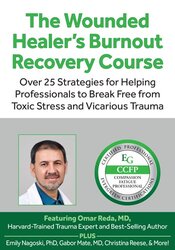Understanding the Stress Cycle: Insights for Therapists

As therapists, weãre often in the position of guiding our clients through stress, helping them navigate complex emotions, and find pathways to healing. But how often do we pause to understand the stress cycle in our own livesãand how it impacts both us and those we work with?
However, in modern lifeãand particularly in therapy workãstressors often donãt resolve as neatly as escaping a charging predator. The unresolved stress accumulates, leaving us stuck mid-cycle. Over time, this can lead to burnout, physical ailments, and emotional exhaustion.
For therapists, this is a critical concept. Not only do we face personal stress, but we also engage deeply with clientsã emotional struggles. Without strategies to complete our own stress cycles, we risk losing the balance and well-being needed to support our clients effectively.
The ultimate cure for burnout isnãt just self-careãitãs caring for each other. Building supportive professional networks and creating environments that prioritize collective well-being are essential for maintaining resilience.
By understanding and addressing the stress cycle in our own lives, we empower ourselves to be more present, effective, and compassionate in our work as therapists.
What Is the Stress Cycle?
The stress cycle is a physiological process our bodies undergo when faced with stressors. It begins with a triggerãanything from a looming deadline to a difficult client sessionãthat activates our fight, flight, or freeze response. This response prepares us to deal with the perceived threat by releasing stress hormones like adrenaline and cortisol. Ideally, once the stressor is resolved, we engage in behaviors that signal to our body that weãre safe, completing the stress response cycle.However, in modern lifeãand particularly in therapy workãstressors often donãt resolve as neatly as escaping a charging predator. The unresolved stress accumulates, leaving us stuck mid-cycle. Over time, this can lead to burnout, physical ailments, and emotional exhaustion.
Why Completing the Stress Cycle Matters
Stress itself isnãt the enemyãitãs uncompleted stress cycles that wreak havoc on our health. Unresolved stress keeps our bodies in a heightened state, suppressing vital systems like digestion and immunity and leading to long-term damage such as cardiovascular issues or chronic pain.For therapists, this is a critical concept. Not only do we face personal stress, but we also engage deeply with clientsã emotional struggles. Without strategies to complete our own stress cycles, we risk losing the balance and well-being needed to support our clients effectively.
Strategies to Complete the Stress Cycle
- Physical Activity: Moving your body is one of the most effective ways to complete the stress cycle. This could be as simple as a brisk walk, dancing in your living room, or practicing yoga. Physical activity helps metabolize stress hormones and signals to your body that youãre no longer in danger.
- Creative Expression: Writing, painting, or even knitting can offer a powerful release for pent-up stress. These outlets provide a space to process and transform unresolved emotions.
- Connection: Engage with loved ones or your professional community. Authentic connection reminds our bodies that weãre not alone and can activate calming responses.
- Crying or Laughing: Both crying and laughing are natural ways for our bodies to release emotional tension and complete the stress response.
- Imagination and Visualization: For those unable to physically engage in stress-relief activities, visualization can be a helpful alternative. Imagining yourself overcoming stressorsãwhether itãs conquering a mountain or slaying metaphorical dragonsãcan help your body process emotions.
- Rest and Recovery: Adequate sleep and moments of intentional rest are essential. Practices like deep breathing, meditation, or simply sipping tea in silence allow your body to reset and recharge.
Stress in the Therapy Room
Therapists often face unique stressorsãholding space for othersã pain, managing professional responsibilities, and navigating systemic challenges. Recognizing how these stressors impact your own stress cycle is the first step to ensuring you donãt get stuck. Consider embedding stress-cycle strategies into your daily routine and modeling these behaviors for your clients.The ultimate cure for burnout isnãt just self-careãitãs caring for each other. Building supportive professional networks and creating environments that prioritize collective well-being are essential for maintaining resilience.
By understanding and addressing the stress cycle in our own lives, we empower ourselves to be more present, effective, and compassionate in our work as therapists.
The Wounded Healerãs Burnout Recovery Course: Over 25 Strategies for Helping Professionals to Break Free from Toxic Stress & Vicarious Trauma

Reignite your passion for helping others through practical strategies designed for real-world professionals. This course is your lifeline for breaking the cycle of vicarious trauma, compassion fatigue, toxic stress and more! PLUS, you'll be eligible to earn your Certified Compassion Fatigue Professional certification for free!
Meet the Expert:
Emily Nagoski, Ph.D., as been a sex educator for twenty years and is the former inaugural Director of Wellness Education at Smith College. Her New York Times bestselling book, Come As You Are: The Surprising New Science That Will Transform Your Sex Life, has been hailed as a groundbreaking exploration of the science of sexuality. Sex therapist, Ian Kerner called it a ãmaster class in the science of sexã and relationship researcher John Gottman said it is ãan absolutely necessary guide for all couples.ã She has also written three guides for Ian Kernerãs GoodInBed.com, including the ãGuide to Female Orgasm,ã and her own blog, The Dirty Normal.
Learn more about her educational products, including upcoming live seminars, by clicking here.
Learn more about her educational products, including upcoming live seminars, by clicking here.



